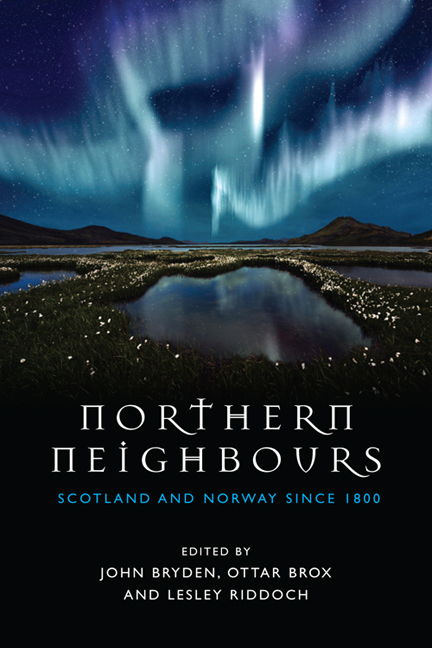Book contents
- Frontmatter
- Contents
- Acknowledgements
- Foreword
- 1 Introduction
- 2 Towards a Theory of Divergent Development
- 3 Cousins Divided? Development in and of Political Institutions in Scotland and Norway since 1814
- 4 Agrarian Change in Scotland and Norway: Agricultural Production, Structures, Politics and Policies since 1800
- 5 The Evolution of Local Government and Governance in Scotland and Norway
- 6 The Development of Industry and North Sea Oil in Scotland and Norway
- 7 Reflections on the Making of Norway
- 8 Money and Banking in Scotland and Norway
- 9 Religion in Scotland and Norway
- 10 The Nordic Welfare Model in Norway and Scotland
- 11 Access, Nature, Culture and the Great Outdoors – Norway and Scotland
- 12 Education in Norway and Scotland: Developing and Re-forming the Systems
- 13 Norway and the United Kingdom/Scotland after the Second World War
- 14 Conclusions
- The Contributors
- Bibliography
- Index
6 - The Development of Industry and North Sea Oil in Scotland and Norway
Published online by Cambridge University Press: 05 August 2016
- Frontmatter
- Contents
- Acknowledgements
- Foreword
- 1 Introduction
- 2 Towards a Theory of Divergent Development
- 3 Cousins Divided? Development in and of Political Institutions in Scotland and Norway since 1814
- 4 Agrarian Change in Scotland and Norway: Agricultural Production, Structures, Politics and Policies since 1800
- 5 The Evolution of Local Government and Governance in Scotland and Norway
- 6 The Development of Industry and North Sea Oil in Scotland and Norway
- 7 Reflections on the Making of Norway
- 8 Money and Banking in Scotland and Norway
- 9 Religion in Scotland and Norway
- 10 The Nordic Welfare Model in Norway and Scotland
- 11 Access, Nature, Culture and the Great Outdoors – Norway and Scotland
- 12 Education in Norway and Scotland: Developing and Re-forming the Systems
- 13 Norway and the United Kingdom/Scotland after the Second World War
- 14 Conclusions
- The Contributors
- Bibliography
- Index
Summary
INTRODUCTION
There are striking differences between the respective stories of industrial development in Scotland and Norway since the eighteenth century. These especially concern the timing of the shift from ‘proto-industrialisation’ to ‘modern industrialisation’ based on the factory system; the relationship between agrarian, rural, urban and industrial development, especially concerning the peasantry, migration streams and urbanisation; working-class divisions and alliances; attitudes and policies concerning foreign interest and capital in relation to basic resources; the source of energy for modern industry and its impacts on the location of industrial development; the importance of domestic and overseas markets and industrial protection; different ideas on the role of the State and protectionism; and the differential impact of neo-liberal policies after 1970. Mainly as a result of these rather deeply rooted differences, but also because of Scotland's constitutional position within the UK, the story of the development and exploitation of North Sea oil after about 1970 is also quite different, as are its social and economic consequences.
Between 1750 and 2010, Scotland gained and lost a world-class – and worldscale – manufacturing industry. Scottish textiles, iron and steel, coal, ships, railway engines, and the steam engines to drive them all, together with a host of interconnected industries, were the engines of industrial development. At the beginning of this period and for nearly a century, this industrial development was mostly rural, involving pluriactive farmers and their households, based on power from water, charcoal and wood, iron ore from the hills, and linen and wool from Scottish farms and crofts. Until the later stages of the twentieth century, it was also mainly Scottish-owned. At its peak it was largely based on export-orientated ‘heavy’ industry, and for this reason Scottish manufacturing and the people who worked in it suffered disproportionately in recessions. By the middle of the twentieth century, the experience of recessions filled the memories and future thoughts of many. The increasingly hegemonic idea among decision-makers was that Scotland was far too dependent on heavy industry, and that what was needed were more consumer industries. Government policies focused on this task periodically after the Second World War, and traditional industries were either propped up or left to die. When North Sea oil appeared in the early 1970s, neither Scottish nor UK heavy industry was in a position to participate to any real extent.
- Type
- Chapter
- Information
- Northern NeighboursScotland and Norway since 1800, pp. 123 - 153Publisher: Edinburgh University PressPrint publication year: 2015



